Share what you know,
and discover more.
Share what you know,
and discover more.
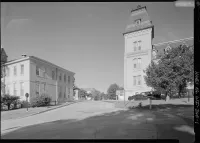
-

- Marley Zielike
National Home for Disabled Volunteer Soldiers, Northwestern Branch, 5000 West National Ave Milwaukee, Milwaukee County, WI
Established by Congress in 1865 and developed as a network of eleven branches across the country, the National Home for Disabled Volunteer Soldiers (NHDVS) established a policy of veteran`s benefits that directly influenced the development of a national system for veteran`s health care in the United States. The NHDVS was a notable departure from the previous focus on care for professional soldiers and officially set forth the concern and commitment of the federal government for the well-being of the civilian soldier. The architecture and landscape architecture of the NHDVS branches reflects development of the institution, and the goal of providing residences and care to war veterans. The highly visible NHDVS branches reminded citizens of the federal government`s support of veterans and helped forge a link between the public and the government. In 1930, the NHDVS was absorbed into the newly created Veterans Administration. With the transition, the practice of establishing and developing individual branches with unique architecture and landscapes ended as these past policies gave way to standardization. This report documents the national significance of the NHDVS from 1865-1930, and evaluates the National Historic Landmark eligibility of the eleven branches for that period.
National Home for Disabled Volunteer Soldiers, Northwestern Branch, 5000 West National Ave Milwaukee, Milwaukee County, WI
Established by Congress in 1865 and developed as a network of eleven branches across the country, the National Home for Disabled Volunteer Soldiers (NHDVS) established a policy of veteran`s benefits that directly influenced the development of a national system for veteran`s health care in the United States. The NHDVS was a notable departure from the previous focus on care for professional soldiers and officially set forth the concern and commitment of the federal government for the well-being of the civilian soldier. The architecture and landscape architecture of the NHDVS branches reflects development of the institution, and the goal of providing residences and care to war veterans. The highly visible NHDVS branches reminded citizens of the federal government`s support of veterans and helped forge a link between the public and the government. In 1930, the NHDVS was absorbed into the newly created Veterans Administration. With the transition, the practice of establishing and developing individual branches with unique architecture and landscapes ended as these past policies gave way to standardization. This report documents the national significance of the NHDVS from 1865-1930, and evaluates the National Historic Landmark eligibility of the eleven branches for that period.
National Home for Disabled Volunteer Soldiers, Northwestern Branch, 5000 West National Ave Milwaukee, Milwaukee County, WI
Established by Congress in 1865 and developed as a network of eleven branches across the country, the National Home for Disabled Volunteer Soldiers (NHDVS) established a policy of veteran`s benefits that directly influenced the development of a national system for veteran`s health care in the United States. The NHDVS was a notable departure from the previous focus on care for professional soldiers and officially set forth the concern and commitment of the federal government for the well-being of the civilian soldier. The architecture and landscape architecture of the NHDVS branches reflects development of the institution, and the goal of providing residences and care to war veterans. The highly visible NHDVS branches reminded citizens of the federal government`s support of veterans and helped forge a link between the public and the government. In 1930, the NHDVS was absorbed into the newly created Veterans Administration. With the transition, the practice of establishing and developing individual branches with unique architecture and landscapes ended as these past policies gave way to standardization. This report documents the national significance of the NHDVS from 1865-1930, and evaluates the National Historic Landmark eligibility of the eleven branches for that period.Posted Date
Sep 27, 2021
Source Name
Library of Congress
Source Website
Delete Story
Are you sure you want to delete this story?
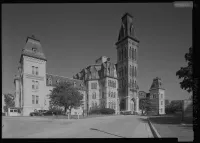
-

- Marley Zielike
National Home for Disabled Volunteer Soldiers, Northwestern Branch, Main Building, 5000 West National Ave Milwaukee, Milwaukee County, WI
The Main Building was constructed in 1868-69 and designed by prominent Milwaukee architect Edward Townsend Mix. It was the primary purpose-built structure for the Northwestern Branch of the National Asylum for Disabled Volunteer Soldiers (renamed National Home for Disabled Volunteer Soldiers in 1873). This new federal institution was authorized by Congress in 1865 and charged with caring for Civil War veterans disabled by their military service. That the Northwestern Branch was located in Milwaukee in 1866 was largely due to the fundraising and organization already completed by the Wisconsin Soldiers` Home Society. The Milwaukee women who spearheaded this effort donated $95,000 to the cause and a picturesque campus was established west of the city. Mix`s design for the new Soldiers` Home building was a Victorian Gothic pile with a tall central tower and large flanking wings, prominently placed on a ridge looking east toward the city. Originally intended to be a multipurpose structure housing living quarters, mess hall, kitchen, chapel, offices, and recreation facilities, the Main Building was almost immediately too small for the demands of veterans care, in spite of its impressive size. The end towers, a modification of those omitted during the original building campaign, were added in 1875-76 to expand the living space. Shortly thereafter, expansion of the Northwestern Branch focused on adding new purpose-built structures, including a hospital (1879), theater and home store (1881), chapel (1889), library (1891), and headquarters building with post office (1895). With many of these functions now removed from this structure, living quarters were expanded accordingly and the structure continued to function as a "domiciliary" with bedrooms, mess hall, and common areas until the 1980s.
National Home for Disabled Volunteer Soldiers, Northwestern Branch, Main Building, 5000 West National Ave Milwaukee, Milwaukee County, WI
The Main Building was constructed in 1868-69 and designed by prominent Milwaukee architect Edward Townsend Mix. It was the primary purpose-built structure for the Northwestern Branch of the National Asylum for Disabled Volunteer Soldiers (renamed National Home for Disabled Volunteer Soldiers in 1873). This new federal institution was authorized by Congress in 1865 and charged with caring for Civil War veterans disabled by their military service. That the Northwestern Branch was located in Milwaukee in 1866 was largely due to the fundraising and organization already completed by the Wisconsin Soldiers` Home Society. The Milwaukee women who spearheaded this effort donated $95,000 to the cause and a picturesque campus was established west of the city. Mix`s design for the new Soldiers` Home building was a Victorian Gothic pile with a tall central tower and large flanking wings, prominently placed on a ridge looking east toward the city. Originally intended to be a multipurpose structure housing living quarters, mess hall, kitchen, chapel, offices, and recreation facilities, the Main Building was almost immediately too small for the demands of veterans care, in spite of its impressive size. The end towers, a modification of those omitted during the original building campaign, were added in 1875-76 to expand the living space. Shortly thereafter, expansion of the Northwestern Branch focused on adding new purpose-built structures, including a hospital (1879), theater and home store (1881), chapel (1889), library (1891), and headquarters building with post office (1895). With many of these functions now removed from this structure, living quarters were expanded accordingly and the structure continued to function as a "domiciliary" with bedrooms, mess hall, and common areas until the 1980s.
National Home for Disabled Volunteer Soldiers, Northwestern Branch, Main Building, 5000 West National Ave Milwaukee, Milwaukee County, WI
The Main Building was constructed in 1868-69 and designed by prominent Milwaukee architect Edward Townsend Mix. It was the primary purpose-built structure for the Northwestern Branch of the National Asylum for Disabled Volunteer Soldiers (renamed National Home for Disabled Volunteer Soldiers in 1873). This new federal institution was authorized by Congress in 1865 and charged with caring for Civil War veterans disabled by their military service. That the Northwestern Branch was located in Milwaukee in 1866 was largely due to the fundraising and organization already completed by the Wisconsin Soldiers` Home Society. The Milwaukee women who spearheaded this effort donated $95,000 to the cause and a picturesque campus was established west of the city.Mix`s design for the new Soldiers` Home building was a Victorian Gothic pile with a tall central tower and large flanking wings, prominently placed on a ridge looking east toward the city. Originally intended to be a multipurpose structure housing living quarters, mess hall, kitchen, chapel, offices, and recreation facilities, the Main Building was almost immediately too small for the demands of veterans care, in spite of its impressive size. The end towers, a modification of those omitted during the original building campaign, were added in 1875-76 to expand the living space. Shortly thereafter, expansion of the Northwestern Branch focused on adding new purpose-built structures, including a hospital (1879), theater and home store (1881), chapel (1889), library (1891), and headquarters building with post office (1895). With many of these functions now removed from this structure, living quarters were expanded accordingly and the structure continued to function as a "domiciliary" with bedrooms, mess hall, and common areas until the 1980s.
Posted Date
Sep 27, 2021
Source Name
Library of Congress
Source Website
Delete Story
Are you sure you want to delete this story?
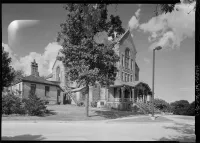
-

- Marley Zielike
National Home for Disabled Volunteer Soldiers, Northwestern Branch, Ward Memorial Hall, 5000 West National Ave Milwaukee, Milwaukee County, WI
- The original drawings transmitted the the Library of Congress in 2010 contained errors and were replaced by corrected drawings in 2013.
National Home for Disabled Volunteer Soldiers, Northwestern Branch, Ward Memorial Hall, 5000 West National Ave Milwaukee, Milwaukee County, WI
- The original drawings transmitted the the Library of Congress in 2010 contained errors and were replaced by corrected drawings in 2013.
National Home for Disabled Volunteer Soldiers, Northwestern Branch, Ward Memorial Hall, 5000 West National Ave Milwaukee, Milwaukee County, WI
-The original drawings transmitted the the Library of Congress in 2010 contained errors and were replaced by corrected drawings in 2013.
Posted Date
Sep 27, 2021
Source Name
Library of Congress
Source Website
Delete Story
Are you sure you want to delete this story?
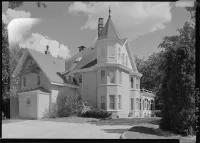
-

- Marley Zielike
National Home for Disabled Volunteer Soldiers, Northwestern Branch, Governor`s Residence, 5000 West National Ave Milwaukee, Milwaukee County, WI
Governor`s Residence is thought to have been built in 1868-69 and designed by prominent Milwaukee architect Edward Townsend Mix, concurrent with construction of the Main Building. It housed the Governor for the Northwestern Branch of the National Asylum for Disabled Volunteer Soldiers (renamed National Home for Disabled Volunteer Soldiers in 1873). This new federal institution was authorized by Congress in 1865 and charged with caring for Civil War veterans disabled by their military service. The original design for the Soldiers` Home Governor`s Residence was an Italianate Villa with a corner tower. The house was expanded during the 1890s and the new roofline and gables gave it a Queen Anne appearance. The house still serves as a residence for the Director of the Zablocki Veterans Affairs Medical Center.
National Home for Disabled Volunteer Soldiers, Northwestern Branch, Governor`s Residence, 5000 West National Ave Milwaukee, Milwaukee County, WI
Governor`s Residence is thought to have been built in 1868-69 and designed by prominent Milwaukee architect Edward Townsend Mix, concurrent with construction of the Main Building. It housed the Governor for the Northwestern Branch of the National Asylum for Disabled Volunteer Soldiers (renamed National Home for Disabled Volunteer Soldiers in 1873). This new federal institution was authorized by Congress in 1865 and charged with caring for Civil War veterans disabled by their military service. The original design for the Soldiers` Home Governor`s Residence was an Italianate Villa with a corner tower. The house was expanded during the 1890s and the new roofline and gables gave it a Queen Anne appearance. The house still serves as a residence for the Director of the Zablocki Veterans Affairs Medical Center.
National Home for Disabled Volunteer Soldiers, Northwestern Branch, Governor`s Residence, 5000 West National Ave Milwaukee, Milwaukee County, WI
Governor`s Residence is thought to have been built in 1868-69 and designed by prominent Milwaukee architect Edward Townsend Mix, concurrent with construction of the Main Building. It housed the Governor for the Northwestern Branch of the National Asylum for Disabled Volunteer Soldiers (renamed National Home for Disabled Volunteer Soldiers in 1873). This new federal institution was authorized by Congress in 1865 and charged with caring for Civil War veterans disabled by their military service. The original design for the Soldiers` Home Governor`s Residence was an Italianate Villa with a corner tower. The house was expanded during the 1890s and the new roofline and gables gave it a Queen Anne appearance. The house still serves as a residence for the Director of the Zablocki Veterans Affairs Medical Center.Posted Date
Sep 27, 2021
Source Name
Library of Congress
Source Website
Delete Story
Are you sure you want to delete this story?
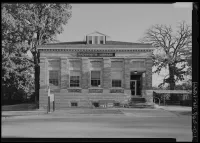
-

- Marley Zielike
National Home for Disabled Volunteer Soldiers, Northwestern Branch, Wadsworth Library, 5000 West National Ave Milwaukee, Milwaukee County, WI
The Wadsworth Library was built in 1891-92 during a period of expansion for the Northwestern Branch of the National Home for Disabled Volunteer Soldiers. Originally the recreational facilities for resident veterans were housed in the multi-purpose Main Building, including a room designated as a library. Expansion of the membership and a shift away from the centralized model in the 1880s and 1890s resulted in the construction of a number of specialized new buildings, including the library. The library is attributed to prominent Milwaukee architect Henry C. Koch. Koch`s firm was the architect for many buildings during this period of expansion including the hospital (1879), Ward Memorial Hall (1881), and chapel (1889). The library is still used for its original purpose and is an important part of the historic core of the Northwestern Branch campus.
National Home for Disabled Volunteer Soldiers, Northwestern Branch, Wadsworth Library, 5000 West National Ave Milwaukee, Milwaukee County, WI
The Wadsworth Library was built in 1891-92 during a period of expansion for the Northwestern Branch of the National Home for Disabled Volunteer Soldiers. Originally the recreational facilities for resident veterans were housed in the multi-purpose Main Building, including a room designated as a library. Expansion of the membership and a shift away from the centralized model in the 1880s and 1890s resulted in the construction of a number of specialized new buildings, including the library. The library is attributed to prominent Milwaukee architect Henry C. Koch. Koch`s firm was the architect for many buildings during this period of expansion including the hospital (1879), Ward Memorial Hall (1881), and chapel (1889). The library is still used for its original purpose and is an important part of the historic core of the Northwestern Branch campus.
National Home for Disabled Volunteer Soldiers, Northwestern Branch, Wadsworth Library, 5000 West National Ave Milwaukee, Milwaukee County, WI
The Wadsworth Library was built in 1891-92 during a period of expansion for the Northwestern Branch of the National Home for Disabled Volunteer Soldiers. Originally the recreational facilities for resident veterans were housed in the multi-purpose Main Building, including a room designated as a library. Expansion of the membership and a shift away from the centralized model in the 1880s and 1890s resulted in the construction of a number of specialized new buildings, including the library. The library is attributed to prominent Milwaukee architect Henry C. Koch. Koch`s firm was the architect for many buildings during this period of expansion including the hospital (1879), Ward Memorial Hall (1881), and chapel (1889). The library is still used for its original purpose and is an important part of the historic core of the Northwestern Branch campus.Posted Date
Sep 27, 2021
Source Name
Library of Congress
Source Website
Delete Story
Are you sure you want to delete this story?
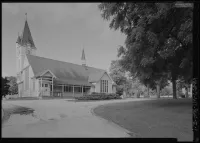
-

- Marley Zielike
National Home for Disabled Volunteer Soldiers, Northwestern Branch, Chapel, 5000 West National Ave Milwaukee, Milwaukee County, WI
The Chapel was built in 1889 during a period of expansion for the Northwestern Branch of the National Home for Disabled Volunteer Soldiers. Originally a chapel for resident veterans was located above the dining hall in the multi-purpose Main Building. Expansion of the membership and a shift away from the centralized model in the 1880s and 1890s resulted in the construction of a number of specialized new buildings, including the chapel. The wood-frame chapel was designed by prominent Milwaukee architect Henry C. Koch using the popular Shingle Style variation of Queen Anne architecture. Koch`s firm was the architect for many buildings during this period of expansion including the hospital (1879), Ward Memorial Hall (1881), and the library (1891).
National Home for Disabled Volunteer Soldiers, Northwestern Branch, Chapel, 5000 West National Ave Milwaukee, Milwaukee County, WI
The Chapel was built in 1889 during a period of expansion for the Northwestern Branch of the National Home for Disabled Volunteer Soldiers. Originally a chapel for resident veterans was located above the dining hall in the multi-purpose Main Building. Expansion of the membership and a shift away from the centralized model in the 1880s and 1890s resulted in the construction of a number of specialized new buildings, including the chapel. The wood-frame chapel was designed by prominent Milwaukee architect Henry C. Koch using the popular Shingle Style variation of Queen Anne architecture. Koch`s firm was the architect for many buildings during this period of expansion including the hospital (1879), Ward Memorial Hall (1881), and the library (1891).
National Home for Disabled Volunteer Soldiers, Northwestern Branch, Chapel, 5000 West National Ave Milwaukee, Milwaukee County, WI
The Chapel was built in 1889 during a period of expansion for the Northwestern Branch of the National Home for Disabled Volunteer Soldiers. Originally a chapel for resident veterans was located above the dining hall in the multi-purpose Main Building. Expansion of the membership and a shift away from the centralized model in the 1880s and 1890s resulted in the construction of a number of specialized new buildings, including the chapel. The wood-frame chapel was designed by prominent Milwaukee architect Henry C. Koch using the popular Shingle Style variation of Queen Anne architecture. Koch`s firm was the architect for many buildings during this period of expansion including the hospital (1879), Ward Memorial Hall (1881), and the library (1891).Posted Date
Sep 27, 2021
Source Name
Library of Congress
Source Website
Delete Story
Are you sure you want to delete this story?
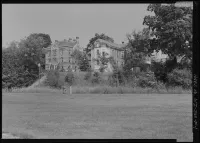
-

- Marley Zielike
National Home for Disabled Volunteer Soldiers, Northwestern Branch, Hospital, 5000 West National Ave Milwaukee, Milwaukee County, WI
This hospital was built in 1879, inaugurating a period of expansion for the Northwestern Branch of the National Home for Disabled Volunteer Soldiers. Originally hospital facilities were located in a modest brick structure built in 1867 (now demolished). Expansion of the membership, more emphasis on medical care for veterans, and a shift away from the centralized model resulted in the construction of a number of specialized new buildings. The hospital was the first in a series of new Soldiers` Home buildings designed by prominent Milwaukee architect Henry C. Koch. Koch`s firm was the architect for many buildings during this period of expansion including Ward Memorial Hall (1881), several barracks, the chapel (1889) and the headquarters building and the library (1891).
National Home for Disabled Volunteer Soldiers, Northwestern Branch, Hospital, 5000 West National Ave Milwaukee, Milwaukee County, WI
This hospital was built in 1879, inaugurating a period of expansion for the Northwestern Branch of the National Home for Disabled Volunteer Soldiers. Originally hospital facilities were located in a modest brick structure built in 1867 (now demolished). Expansion of the membership, more emphasis on medical care for veterans, and a shift away from the centralized model resulted in the construction of a number of specialized new buildings. The hospital was the first in a series of new Soldiers` Home buildings designed by prominent Milwaukee architect Henry C. Koch. Koch`s firm was the architect for many buildings during this period of expansion including Ward Memorial Hall (1881), several barracks, the chapel (1889) and the headquarters building and the library (1891).
National Home for Disabled Volunteer Soldiers, Northwestern Branch, Hospital, 5000 West National Ave Milwaukee, Milwaukee County, WI
This hospital was built in 1879, inaugurating a period of expansion for the Northwestern Branch of the National Home for Disabled Volunteer Soldiers. Originally hospital facilities were located in a modest brick structure built in 1867 (now demolished). Expansion of the membership, more emphasis on medical care for veterans, and a shift away from the centralized model resulted in the construction of a number of specialized new buildings. The hospital was the first in a series of new Soldiers` Home buildings designed by prominent Milwaukee architect Henry C. Koch. Koch`s firm was the architect for many buildings during this period of expansion including Ward Memorial Hall (1881), several barracks, the chapel (1889) and the headquarters building and the library (1891).Posted Date
Sep 27, 2021
Source Name
Library of Congress
Source Website
Delete Story
Are you sure you want to delete this story?
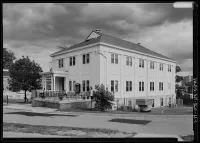
National Home for Disabled Volunteer Soldiers, Northwestern Branch, Recreation Building, 5000 West National Ave Milwaukee, Milwaukee County, WI
HABS WI-360-H
National Home for Disabled Volunteer Soldiers, Northwestern Branch, Recreation Building, 5000 West National Ave Milwaukee, Milwaukee County, WI
HABS WI-360-HPosted Date
Sep 27, 2021
Source Name
Library of Congress
Source Website
Delete Story
Are you sure you want to delete this story?
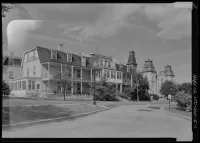
National Home for Disabled Volunteer Soldiers, Northwestern Branch, Barracks, 5000 West National Ave Milwaukee, Milwaukee County, WI
HABS WI-360-I
National Home for Disabled Volunteer Soldiers, Northwestern Branch, Barracks, 5000 West National Ave Milwaukee, Milwaukee County, WI
HABS WI-360-IPosted Date
Sep 27, 2021
Source Name
Library of Congress
Source Website
Delete Story
Are you sure you want to delete this story?
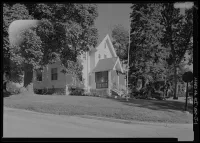
National Home for Disabled Volunteer Soldiers, Northwestern Branch, Catholic Chaplain`s Quarters, 5000 West National Ave Milwaukee, Milwaukee County, WI
HABS WI-360-J
National Home for Disabled Volunteer Soldiers, Northwestern Branch, Catholic Chaplain`s Quarters, 5000 West National Ave Milwaukee, Milwaukee County, WI
HABS WI-360-JPosted Date
Sep 27, 2021
Source Name
Library of Congress
Source Website
Delete Story
Are you sure you want to delete this story?










